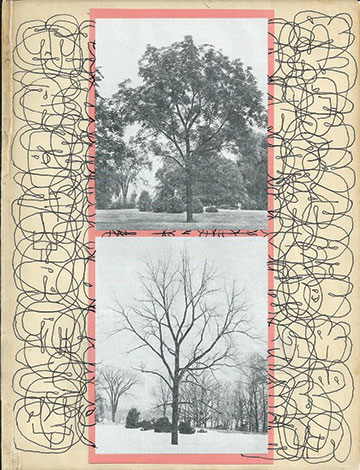Next story: Timothy Noble's Drawing Machine at the Burchfield Penney
Works by Dylan England at 464 Gallery
by Gerald Mead



Poetic Collages
It is very possible that Dylan England is the region’s most gifted emerging artist working in collage. That may sound like an overly generous statement, but his work is really that good. The only downside is that his artwork is largely unknown to Western New York audiences since the current exhibition at 464 Gallery is only the second time that a substantial body of his work has been shown in the area. (The first was in 2012 at the now shuttered Vault on Main Street.) The invitation to show his work at 464 Gallery came after England won awards in both of the gallery’s annual “Vision Art Awards” competitions and garnered unequivocal praise from the judges.
Approaches to collage vary widely and range from the highly detailed abstractions of former UB Professor Seymour Drumlevitch (1923-1989) to the more sparse poetic compositions of representational imagery by the historic master of the medium, Joseph Cornell (1903-1972). More in line with the latter, England’s collages expertly achieve maximum meaning with a minimal use of imagery. Each one of the 21 works, neatly hung in a single row from binder clips, are ideal expressions of how all the elements of constructing a collage—choosing images, editing, composing and assembling—perfectly coalesce, and the result is an exceptionally cohesive series of works.
The inspiration and eventual source material for his modestly scaled artworks is vintage (circa 1950-1970) monochromatic or black-and-white photographic images taken from books. The hues and quality of the printed images convey a sense of nostalgia and the bucolic treescapes and idyllic midcentury homes suggest a more utopian time and its promises of suburban bliss. England deftly manipulates and subtly combines these images to disrupt their meaning, or as the artist states, “to extrapolate my own narratives.” Those narratives revolve around the evolution of memories of growing up and the homes and spaces that imprinted those memories.
In each of the works, England develops a thoughtful relationship (conceptually and compositionally) between the image he has selected for the substrate of the collage and the images applied on them, often revealing the essential qualities of each of the component images in the process. It is these imaginative and insightful juxtapositions that are the key to the success of the works and the indeterminate line between reality and illusion that weaves through the collages is just one of the reasons they are so compelling.
In some works, such as Dogwood and White Pine, the artist’s hand is barely discernible as the images he combines seamlessly merge and entice viewers to examine them at close range. In others, the intersections are more dramatic. The main component of Backyard is a green-hued image of a sun-dappled lawn abutting a stand of trees. It is peaceful, serene, and familiar and conveys suburban idealism. By placing an intense red “triangle within a circle” form on the upper half of the image, the scene is dramatically transformed and now alludes to some sinister force that lurks below the semblance of perfection. The irony here is that the intense red shape might be misinterpreted as a detail of beautiful, autumnal foliage. In reality, it is a detail of molten lava and in this context its texture/color serves as a symbol of destruction or impending doom. This is just one example of the thoughtful subtexts that England creates in this series of keenly edited and meticulously crafted collages, and there are many more.
The collage technique often includes the use of text and in several works England incorporates blocks of bubble letters, crisply hand drawn atop the images. He uses this unique graphic device—strong enough to stand on its own in some pieces—as a leitmotif in the series. The overlay of words they spell out horizontally and vertically are dense enough to thwart reading them yet open enough to serve as an elegant latticework that interacts with the images and infuse them with a sort of “visual noise.” Instead of overly complicating the refined compositions of the works, the letter mazes actually reinforce the structure inherent in the images.
Max Ernst (1891-1976), one of the leading artists of the Surrealist movement, described collage as the “spark of poetry” that is given off when artists combine unrelated elements on a single surface. That is an apt description for the effect that England has achieved with his well conceived and simply constructed collages and his invitation to us to muse on their meaning.
This exhibition, enigmatically titled Country Disco: Collage and Drawings by Dylan England, is on view at 464 Gallery through January 29.
blog comments powered by Disqus|
Issue Navigation> Issue Index > v13n3 (Week of Thursday, January 16) > Art Scene > Works by Dylan England at 464 Gallery This Week's Issue • Artvoice Daily • Artvoice TV • Events Calendar • Classifieds |









 Current Issue
Current Issue